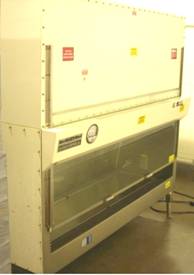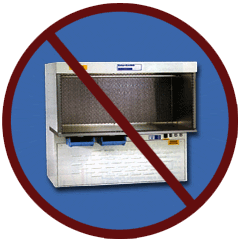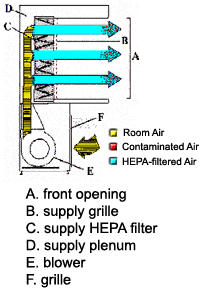BIOHAZARDOUS MATERIALS
- Autoclaves (PDF)
- Biological Use Registration (PDF)
- Biosafety Cabinets
- Biosafety Manual (PDF)
- Bloodborne Pathogens
- Biological Waste Disposal
- Standard Microbiological Work Practices
- CDC's Office of Health and Safety Website (Link)
Labs with Biosafety Level 2 (BSL-2) materials must have an approved Biological Use Registration and a BSL-2 sticker on their Room (hazards) sign. Work with biological materials can be done safely when basic principles are understood and good work practices are followed.
- Doors to lab must be kept closed when infectious materials are in use to alert non-lab personnel not to enter the lab.
- Hand washing is one of the most important ways of controlling infection. Laboratory personnel must wash their hands after they handle viable materials, remove gloves, and before they leave the laboratory.
- All procedures are performed carefully to minimize the creation of splashes and aerosols. Procedures with potential to create aerosols or splashes of infectious materials must be performed in a biosafety cabinet.
- Disinfect all work surfaces at the beginning of the work day, after use, immediately following a spill and at the end of the work day.
- Prohibit mouth pipetting. Suction bulbs or pipetting devices must be used.
Biological Safety Cabinets (BSC)
1. BSC Certification & Maintenance
The College of Science and Engineering uses Technical Safety Services for all services related to biosafety cabinet certification, decontamination and repair. Contact your department stockroom or COSE Health and Safety Staff for the following biosafety cabinet-related issues:
- A new cabinet: Requires initial certification before using.
- A cabinet that has been moved: Requires re-certification before using.
- A cabinet in need of troubleshooting or repairs
2. Using Biosafety Cabinets
 The biological safety cabinet is designed to reduce the potential escape of research material into the worker's environment and to remove contaminants from the research work zone. Danger to personnel and to success of the scientific investigations from carelessly or improperly used protective equipment cannot be over-emphasized.
The biological safety cabinet is designed to reduce the potential escape of research material into the worker's environment and to remove contaminants from the research work zone. Danger to personnel and to success of the scientific investigations from carelessly or improperly used protective equipment cannot be over-emphasized.
The Class II Laminar Flow Biological Safety Cabinet, or the Biosafety Cabinet, combines product, operator and environmental protection. It was developed to provide protection from diverse types of biohazardous material. The biosafety cabinet is similar to the conventional fume hood in providing protection for the operator. It differs from the conventional fume hood by also offering protection for the work in progress and the environment.
Caution: Biosafety cabinets look similar to chemical fume hoods and "clean benches." If you work with biohazard material, make sure you're using a biosafety cabinet.
3. Clean Benches vs. Biosafety Cabinets
 |
Horizontal laminar flow clean air benches are inappropriate for use with any potentially biohazardous material including human source material (clinical specimens, blood, tissue, etc.), cell cultures, infectious agents, or infected animal tissue. Horizontal laminar flow clean air benches are also inappropriate for use with uninfected animals (lab animal allergy), hazardous chemicals and volatile radioisotopes. Work with these materials should be conducted in a Class II biological safety cabinet. |
|
|
The CDC/NIH publication "Primary Containment for Biohazards: Selection, Installation and Use of Biological Safety Cabinets" states: These benches should never be used when handling cell culture materials or drug formulations, or when manipulating potentially infectious materials. The worker can be exposed to materials (including proteinaceous antigens) being manipulated on the clean bench, which may cause hypersensitivity. Horizontal laminar flow clean air benches should never be used as a substitute for a biological safety cabinet in research, biomedical or veterinary laboratories and/or applications." |
|
For more information about biosafety cabinets, see Primary Containment for Biohazards: Selection, Installation and Use of Biological Safety Cabinets from the Centers for Disease Control and Prevention. |
|
4. Biosafety Cabinet Use Guidelines
Laboratory procedures that could create airborne biohazards should be performed in a biosafety cabinet. Biosafety cabinets (BSCs) protect lab workers and the environment from aerosols or droplets that could spread biohazard material.
Do not use fume hoods or clean benches for biohazard materials work. Fume hoods are designed for work with chemicals. Clean benches are intended to protect the research product, not the worker.
Certification: The certification process ensures that the BSC is working as designed. Annual recertification is required for all BSCs used for work with biological materials. COSE has a preferred vendor for certification and maintenance. Notify the stockroom manager or COSE Health and Safety Staff in advance if you plan to relocate a BSC or purchase a new one.
Biosafety cabinets must be re-certified each time they are moved or installed.
Installation: Choose a location away from pedestrian traffic, doors, and air currents generated by room ventilation — all of which can disrupt airflow. Because even small moves can disturb the HEPA filter.
5. Biosafety Cabinet Classification
Class I biosafety cabinet |
A ventilated cabinet with an inward airflow and outlet HEPA filters. It was previously referred to as the CDC Hood and served a valuable function in its time by protecting personnel and the environment. Because it offers no product protection, it has been essentially obsolete for the past several decades. |
Class II (types A and B) |
Laminar Flow Biological Safety Cabinets that protect personnel, product and environment. They provide inward airflow to protect personnel, downflow HEPA filtered air to the work area to protect the product and exhaust HEPA filtered air to protect the environment from particulate and aerosol hazards. |
Class III cabinet |
Essentially a ventilated glovebox. This is a gas-tight chamber operated through sealed gloves which provide a complete barrier between the worker and hazardous material. The glovebox is maintained under negative pressure with HEPA filtered supply air and double HEPA filtered exhaust air. |
Purchase recommendation: Several kinds of BSCs are available, divided into classes (I, II, and III) and types (A, B, C). The COSE recommends departments purchase Class II, Type A2 cabinets.
-
Class II cabinets are designed to protect the research material as well as the worker and the environment. Both the supply air and the exhaust pass through a HEPA filter. There are 4 types of Class II cabinets.
-
Class II Type A2 cabinets (formerly labeled Type A/ B3) have a number of design features that make them more useful in research laboratories than other Class II cabinets.
Note: Class I and Class III cabinets are rarely used at SFSU. Class I cabinets do not protect the research material, and Class III cabinets (also called glove boxes) are completely contained cabinets that require workers to wear arm-length gloves attached to a front panel.
Biological Waste Disposal Overview
All waste biological materials that are potentially hazardous to humans, the environment, or to landfill or water treatment operations must be rendered sterile before disposal or transferred to a licensed contractor for disposal. For more information on COSE policies concerning biological waste, checkout Section D of the COSE Biosafety Manual.
Waste Category |
Examples |
Treatment and Disposal |
Liquid human and animal waste
|
Student blood
|
Store and package in place
|
Pathological Waste
|
Sacrificed animals and parts
|
Store and package in place
|
Medical SharpsUsed during work with humans or animals |
Needles
|
Collect in approved red sharps container
|
Standard SharpsNot contaminated |
Pasteur pipettes
|
Collect uncontaminated broken glassware, etc. in a cardboard box, label, and tape closed.
|
Solid Waste (non-sharp)Solid objects, no liquids |
Gloves |
Collect in an autoclavable biohazard bag (Autoclavable) |
“Mixed” Biological WasteMaterial with one or more hazardous components other than biohazards. |
Alcohol/biological mixtures Radioisotope marked cell cultures or microbes |
Contact COSE Health and Safety staff for assistance in handling mixed hazard wastes. (1) Organic solvents, like ethanol or formalin solutions, are not autoclavable and must be drained off for disposal as hazardous waste (2) Biological waste contaminated with radioactive materials requires special handling. Contact RSO for disposal or questions about radioactive waste (Not autoclavable) |
Standard Microbiological Practices
Standard Microbiological Practices refer to the basic safe laboratory work protocols for working with non-pathogenic biological materials (i.e., BSL-1). Laboratory personnel must have specific training in the procedures conducted in the laboratory. A qualified faculty or staff person must provide this training and provide sufficient supervision to adequately operate a safe and compliant laboratory.
Work is generally conducted on open bench tops using the following standard microbiological practices.
1. Hygiene and Housekeeping
Keeping work areas clean and uncluttered reduces the chance for cross-contamination and inadvertent exposure to biohazards. To avoid ingestion of contaminated material, use a mechanical pipetting device, keep food out of refrigerators and microwaves in work areas, eat, drink, or apply cosmetics only in designated “clean” areas. Other standard practices include:
- Wear a lab coat and tie back long hair
- Wash hands after removing gloves, before leaving the lab, and when handling materials known or suspected to be contaminated.
- Perform procedures in a manner that minimizes the creation of aerosols.
- Clean work surfaces and decontaminate with a suitable disinfectant at the end of the day and after any spill of potentially hazardous materials.
- Bench tops and floors should be impervious to water and easy to clean.
- Remove gloves before leaving the lab, touching the face, keyboards, or control panels, and before using the elevator
2. Personal Protective Equipment
- Wear gloves if skin on the hand is broken, if a rash is present, and when handling biological waste.
- Remove rings or other jewelry that could puncture gloves.
- Wear the appropriate glove for the hazard. Usually a type of latex glove is recommended for working with biological material.
- Avoid reusing gloves unless they can be decontaminated.
- Wear eyewear approved for UV light or other rays that could damage eyes.
- Wear protective eyewear during procedures in which splashes of microorganisms or other hazardous materials is anticipated.
3. Security and Access
Access to the laboratory should be restricted at the discretion of the laboratory manager when experiments or work with cultures and specimens are in progress. Biohazardous material must be clearly marked with a biohazard symbol.
SFSU Bloodborne Pathogen Prevention Program Summary
If you can reasonably anticipate facing contact with human blood and/or other potentially infectious materials as part of your job duties, you should receive additional training from your instructor or supervisor including an opportunity for interactive questions and answers. Questions about the SFSU Bloodborne Pathogen Exposure Plan should be directed to Campus EHOS at 415.338.1449.
1. What are bloodborne pathogens?
Bloodborne pathogens are microorganisms such as viruses or bacteria that are carried in blood and can cause disease in people. There are many different bloodborne pathogens including malaria, syphilis, and brucellosis, but Hepatitis B (HBV) and the Human Immunodeficiency Virus (HIV) are the two diseases specifically addressed by the OSHA Bloodborne Pathogen Standard. However, it is important to know which bloodborne pathogens (from humans or animals) you may be exposed to at work, especially in laboratories.
2. Since I don’t work in a hospital, how could I potentially be exposed to bloodborne pathogens at work?
- Providing first aid or CPR assistance to an infected individual
- Cleaning up blood, vomit, or other bodily fluids
- Drawing blood in class
- Working with unpreserved human or animal cadavers
3. What are some things I can do to protect myself?
It is extremely important to use personal protective equipment and work practice controls to protect yourself from exposure to bloodborne pathogens.
- Universal Precautions: A prevention strategy, in which all blood and potentially infectious materials are treated as if they are, in fact, infectious. In other words, whether or not you think the blood/body fluid is infected with bloodborne pathogens, you treat it as if it is.
- Personal Protective Equipment: To protect yourself, it is essential to have a barrier between you and the potentially infectious material. This includes wearing impermeable gloves, eye protection, and sometime mouth coverings such as a mask or CPR shield.
- Handwashing: This is one of the most important (and easiest) practices used to prevent transmission of bloodborne pathogens. Hands or other exposed skin should be thoroughly washed as soon as possible following an exposure incident. Avoid harsh, abrasive soaps, as these may open fragile scabs or other sores.
4. What if I swallowed or got splashed with blood or other bodily fluids?
If you believe you have been exposed to potentially infectious blood or bodily fluids, contact campus EHOS at 415.339.1449 or COSE Health and Safety Office at 415.338.6892 to report the incident. You have the right to be medically evaluated by the University physician and to be offered the Hepatitis B vaccine series (HBV shot). The HBV vaccine can still be effective in preventing infection up to 24 hours following the exposure incident.
Although your employer must offer the vaccine to you, you do not have to accept that offer. You may opt to decline the vaccination series, in which case you will be asked to sign a declination form. This does not impact any future decisions following another exposure incident. For more details about the vaccine, please contact Campus EHOS at x8-1449.


